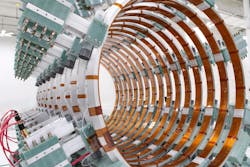Helion Breaks Ground on Orion Nuclear Fusion Facility
The world may not have its first commercially operational nuclear fusion power plant yet, nor even commercial nuclear fusion reactors, but the race is picking up speed to build that infrastructure so the dream reactor will have a place to call home someday.
In the latest industry move to capitalize on a potential buildout of promising nuclear fusion technologies, Helion has started work to construct its first plant in Chelan County, Washington. The Orion facility, when completed and commissioned, would supply fusion-generated electricity to Microsoft by 2028, utilizing Constellation Energy as the power marketer.
Research at Lawrence Livermore National Lab and other experimental sites have achieved some level of net energy gain through nuclear fusion, but no major breakthroughs have happened yet to make it work on a market level. Nonetheless, the promise of carbon-free fusion power is driving a host of investments supporting fusion by companies such as Commonwealth Fusion Systems, Thea Energy and others.
With its site preparation work now underway on Orion, Washington-based Helion leadership is feeling confident they will eventually achieve the energy promises they are building for.
“Today is an important day – not just for Helion, but for the entire fusion industry – as we unleash a new era of energy independence and industrial renewal,” said David Kirtley, Helion’s co-founder and CEO, in a statement. “Since we founded the company, we have been completely focused on preparing fusion technology for commercialization and getting electrons on the grid. Starting site work brings us one step closer to that vision.”
In May 2023, Helion and Microsoft announced what they called the first fusion power purchase agreement (PPA). Microsoft also is based in Washington state, and Constellation Energy will manage electric transmission for the project.
Orion is slated for startup by 2028 and targeting 50 MW or higher after a one-year ramp-up period. Unlike nuclear fission, which splits atoms to create energy and currently powers all of the U.S. commercial nuclear energy fleet, fusion fuses nuclei into larger components using a plasma involving elements such as deuterium, helium, hydrogen, tritium and other elements. It is the type of reaction which powers the suns and stars in the universe.
Helion has previously built six working prototypes and reported reaching 100-million-degree plasma temperatures with its most recent effort. Controlling the plasma at such exponential heat is a major challenge for nuclear fusion technologies. Helion’s particular technology is focused around magneto-inertial fusion, compressing plasma into fusion-level conditions.
Nuclear fusion power generation, like nuclear fission, does not produce carbon emissions. This makes it attractive to large-scale customers aiming to secure electricity resources and meet sustainability and environmental goals.
“We are optimistic that fusion energy can be an important technology to help the world transition to clean energy,” said Brad Smith, Vice Chair and President at Microsoft. “Helion’s announcement supports our own long term clean energy goals and will advance the market to establish a new, efficient method for bringing more clean energy to the grid, faster.”
Microsoft, Meta, Google, Oracle and other digital infrastructure firms are seeking baseload power capacity gains to match growth in the artificial intelligence and data center sectors over the coming decade. The rise in AI and its energy needs is pushing industrial and commercial customers to sign expanded contracts on both nuclear, gas-fired and renewable PPAs.
In fact, Microsoft and Constellation Energy also are collaborating on a long-term PPA, totaling close to $28 billion, that is helping fund the reopening of the retired Three Mile Island Nuclear Unit 1 in Pennsylvania.
Some next-gen energy technology proponents believe that commercial scale for nuclear fusion could become reality over the next decade, considering all the high-level experimentation going on.
“Constellation is committed to innovation and supporting next-generation clean energy technologies to combat the climate crisis, and fusion would be a game-changer,” said Jim McHugh, Chief Commercial Officer at Constellation. “Combined with our hourly carbon-free energy matching solution, Helion and Microsoft are helping to build a future where carbon-free energy is the standard."
Various energy market forecasts from Deloitte, Goldman Sachs, McKinsey and others, are predicting anywhere from 50 to 125 GW in new load from data centers and AI into the early 2030s. A late 2024 U.S. Department of Energy report on future data center demand estimated that data center demand has tripled in the past 10 years and could triple again to 12% of total national electricity demand by 2030.
About the Author
Rod Walton, EnergyTech Managing Editor
Managing Editor
For EnergyTech editorial inquiries, please contact Managing Editor Rod Walton at [email protected].
Rod Walton has spent 17 years covering the energy industry as a newspaper and trade journalist. He formerly was energy writer and business editor at the Tulsa World. Later, he spent six years covering the electricity power sector for Pennwell and Clarion Events. He joined Endeavor and EnergyTech in November 2021.
Walton earned his Bachelors degree in journalism from the University of Oklahoma. His career stops include the Moore American, Bartlesville Examiner-Enterprise, Wagoner Tribune and Tulsa World.
EnergyTech is focused on the mission critical and large-scale energy users and their sustainability and resiliency goals. These include the commercial and industrial sectors, as well as the military, universities, data centers and microgrids. The C&I sectors together account for close to 30 percent of greenhouse gas emissions in the U.S.
He was named Managing Editor for Microgrid Knowledge and EnergyTech starting July 1, 2023
Many large-scale energy users such as Fortune 500 companies, and mission-critical users such as military bases, universities, healthcare facilities, public safety and data centers, shifting their energy priorities to reach net-zero carbon goals within the coming decades. These include plans for renewable energy power purchase agreements, but also on-site resiliency projects such as microgrids, combined heat and power, rooftop solar, energy storage, digitalization and building efficiency upgrades.

